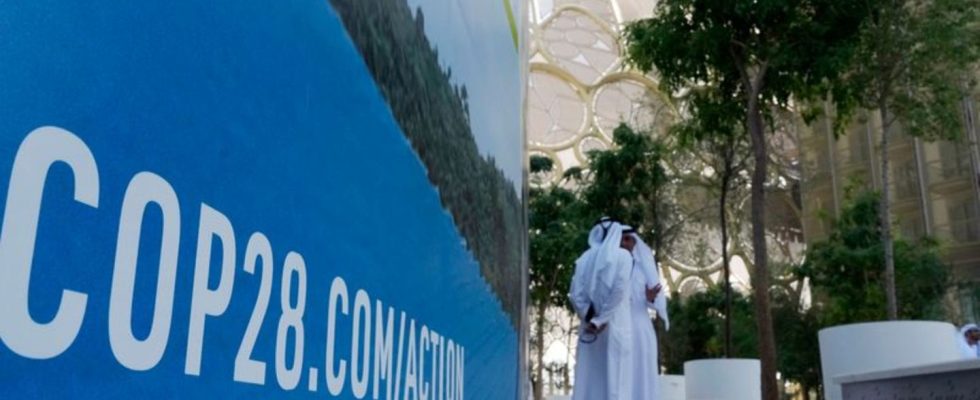The climate conference in Dubai is not exactly under a good star. The world’s attention is on the humanitarian catastrophe in Gaza and the war in Ukraine. Can this work well?
Another climate conference and an important one at that: In Dubai on the Persian Gulf, more than 190 countries would have to decide on a clear correction of the climate course at the COP28 conference from November 30th, because they are discussing the first major inventory of the implementation of the Paris Climate Conference in 2015. And that’s enough and not at the front to limit global warming to 2 degrees or better 1.5 degrees above pre-industrial levels.
The international community agreed on the 1.5 degree target in Paris in order to avoid exceeding dangerous tipping points with irreversible consequences and to avert the most catastrophic consequences of climate change. “Humanity has opened the gates to hell,” said UN Secretary-General António Guterres recently. But the conference doesn’t have a good star, because a few things are putting a strain on the two-week meeting:
wars
The wars in Ukraine and Gaza have pushed the climate crisis out of the headlines. The question is whether the issue will also be sidelined by governments that are concerned with arms deliveries or war diplomacy.
“In 2020, we were also worried that the corona pandemic would suppress the issue of climate change,” said the head of the World Weather Organization (WMO), Petteri Taalas, to the German Press Agency. Nevertheless, there have been quite successful climate conferences. “Of course the war against Ukraine and the Gaza war can cast a shadow over the climate conference, but climate change will still be the biggest challenge of the century if we don’t get it under control.”
Greta and radical climate activists
Climate activist Greta Thunberg is currently causing controversy. At climate demonstrations, in connection with the Gaza war, she speaks of oppressed Palestinians fighting for justice and leaves the stage to a Palestine activist who accuses Israel of genocide.
The German branch of the Fridays for Future movement, which Thunberg launched with her school strike in 2018, has distanced itself from her. There are fears that this will divide the climate movement and make it less powerful. Radical groups like the Last Generation, who stick themselves on streets or in museums or smear paint on the Brandenburg Gate, also put the fight for the climate in a bad light for many people.
The conference location and the COP president
The conference takes place in the oil-rich United Arab Emirates. They are among the countries with the highest per capita emissions of the greenhouse gas CO2. At more than 20 tonnes per capita, they are around three times as high as in Germany. Conference President Sultan Ahmed Al Jaber is also the head of the Abu Dhabi National Oil Company (Adnoc). It is planning to massively expand its oil and gas production.
According to a UN report, the production plans of all governments with an oil and gas industry by 2030 are more than twice as high as would be allowed if the 1.5 degree target is to be achieved. “But we should look in the mirror,” said Taalas. “Who uses fossil energy? Very much Europe, the USA and large Asian countries. The question is whether to punish the drug seller or the drug user.”
The data: Much more ambition is needed
According to the Intergovernmental Panel on Climate Change (IPCC), climate-damaging greenhouse gas emissions must fall by 43 percent by 2030 compared to 2019 in order to meet the 1.5 degree target. According to UN calculations, without new ambitions, there will be a slight increase by 2030. From 2021 to 2022, greenhouse gas emissions rose by 1.2 percent to a new record. “We are currently heading not for 1.5 to 2 degrees of warming, but for 2.5 to 3 degrees,” said Taalas.
The Global Stocktake data is sobering. The pace must be increased rapidly everywhere: a quicker end to the use of fossil fuels oil, gas and coal as well as the deforestation of rainforests, a greater reduction in other greenhouse gases such as methane, a faster switch to sustainable agriculture – and billions to support the poorer countries that do We are already exposed to the consequences of climate change, with droughts, floods, sea level rise and devastating storms.
The bright spots
A lot has happened since the Paris climate agreement: While the world was still on track for 4 degrees of warming in 2015, it is now closer to 2.5 to 3 degrees.
The USA and China also want to work together to ensure that electricity from sustainable sources such as solar and wind is doubled worldwide by 2030 and that there are better battery storage systems. They are the largest contributors to greenhouse gases. Your measures are particularly important.
For the first time, the International Energy Agency (IEA) reports in its annual outlook that demand for coal, gas and oil is expected to peak before 2030 and decline thereafter. The reason is the good expansion of renewable energies and structural changes. The share of fossil fuels in energy production, which has been 80 percent for years, will fall to 73 percent by 2030, she wrote in October.
Federal Foreign Minister Annalena Baerbock (Greens) sees chances that the gradual worldwide phase-out of all fossil energy will be bindingly agreed. In 2021, at the climate conference in Glasgow, India and China pushed through the word phase-down instead of phase-out in the summit decision at the last minute.
WMO boss Taalas still hopes that large countries such as China, India and Brazil will announce more ambitious climate protection plans in Dubai. “I used to be a pessimist, but I have been positively surprised by governments and technological developments,” he said.

